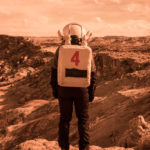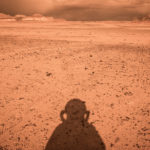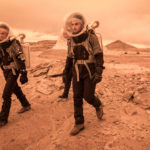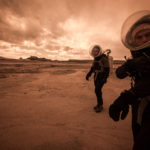MDRS Crew 189: Team ISAE Supaero Mission Plan February 18, 2018
Table of contents
1) Introduction. 2
a. Mars Analog Research Stations
. 2
b. MDRS 189 Mission Origins
. 3
2) Crew 189. 4
a. Crew Bios
. 4
b. Mission preparation and organization. 10
3) Experiments. 10
a. Experimentations planned. 10
Mars Analog Research Stations (text extracted from the Mars Society website)
In order to help develop key knowledge needed to prepare for human Mars exploration, and to inspire the public by making sensuous the vision of human exploration of Mars, the Mars Society has initiated the Mars Analog Research Station (MARS) project. Mars Analog Research Stations are laboratories for learning how to live and work on another planet. Each is a prototype of a habitat that will land humans on Mars and serve as their main base for months of exploration in the harsh Martian environment. Such a habitat represents a key element in current human Mars mission planning. Each Station’s centerpiece is a cylindrical habitat, "The Hab," an 8-meter diameter, two-deck structure mounted on landing struts. Peripheral external structures may be appended to the Hab as well.
Each station serves as a field base to teams of four to six crew members: geologists, astrobiologists, engineers, mechanics, physicians and others, who live for weeks to months at a time in relative isolation in a Mars analog environment. Mars analogs can be defined as locations on Earth where some environmental conditions, geologic features, biological attributes or combinations thereof may approximate in some specific way those thought to be encountered on Mars, either at present or earlier in that planet’s history. Studying such sites leads to new insights into the nature and evolution of Mars, the Earth, and life.
However, in addition to providing scientific insight into our neighboring world, such analog environments offer unprecedented opportunities to carry out Mars analog field research in a variety of key scientific and engineering disciplines that will help prepare humans for the exploration of that planet. Such research is vitally necessary. For example, it is one thing to walk around a factory test area in a new spacesuit prototype and show that a wearer can pick up a wrench – it is entirely another to subject that same suit to two months of real field work. Similarly, psychological studies of human factors issues, including isolation and habitat architecture are also only useful if the crew being studied is attempting to do real work.
| Crew Member |
Country |
MDRS Role |
| Victoria Da-Poian |
France |
Commander |
| Louis Mangin |
France |
Commander |
| Jérémy Auclair |
France |
Greenhab officer |
| Benoit Floquet |
France |
CrewAstronomer |
| Laurent Bizien |
France |
Health & Safety Officer |
| Gabriel Payen |
France |
Crew engineer |
| Alexandre Martin |
France |
Crew journalist |
Team ISAE Supaero has begun their fourth rotation at MDRS, comprised of three weeks of intense research, team building and simulation training on Mars. Our team is composed of seven highly motivated scientists, engineers from the French aerospace engineering school ISAE Supaero.
c. Crew objectives
• To productively function as an interdisciplinary team of aerospace engineering students
• To gain team and individual experience in a Mars analog simulation
• To learn from the team’s collective background and experiences
• To produce a scientifically publishable report, including experimental results
• To promote awareness and passion for space exploration via education and outreach
• To conduct engaging experiments that will be shared on the team website
• To share with the public how research is conducted in an analog situation
• To study crew group dynamics and teamwork of a Mars analog mission
• To obtain scientific results for our sponsors (human factors researchers, CNRS researchers)
• To improve the EVA performances during our simulation
• To fix and clean materials in the station
Victoria Da-Poian will be the Commander of the MDRS-189 mission. She is one of the two veterans taking part in the new mission as she was member of the MDRS-175 crew as the biologist. She is an active member of ISAE Supaero space events as she organized the SpaceUp France in 2017 and took part in different space related associations (space pole and CubeSat club). She was also vice-president of the « Junior Enterprise » of ISAE-Supaero (Supaero Junior Council) and Ambassador of the social and cultural expansion of our school (OSE ISAE Supaero). After her 2017 mission, she completed an internship at the Astronaut Training Center in Cologne (ESA / EAC), and is currently doing an academic exchange in Moscow. In her free time, she enjoys practicing piano, violin and climbing.
Louis Mangin will be with Victoria the commander of the MDRS 189 mission. He was already part of the crew 175 as the journalist. He is currently working as a trainee in Lyon in a start-up that uses the latest AI technologies to minimize the electrical consumption of buildings. When he was living on the campus, he was a rower in the ISAE-Supaero rowing team, organizer of the Supaerowing student regatta, and a tutor with the social association OSE ISAE Supaero. In his free time, he is also a runner, a mountain-climber, a cinephile or a poker player.
Laurent Bizien will be the Health and Safety Officer of the MDRS-189 crew. Promotion 2019 of ISAE Supaero, he is the current treasurer of the school’s charitable association (Solid’aires). As a volunteer firefighter as a lifeguard on the beaches, he passed several first aid diplomas. He is a candidate for a semester at the Moscow State University and an internship at NASA. In his free time, he practices baseball, volleyball and skydiving.
Franco-American born in France, Jérémy Auclair will be the GreenHab Officer and the Biologist on board. Promotion 2019, he is an active member of the club, very invested for the smooth running of the next mission. Passionate about space and astrophysics from his young age, this mission is one more way to flourish in his formation. He plans to do an internship in North America in the field of aerospace. He is also an active member of the school’s associative life, and various clubs with varied backgrounds. During his free time, he enjoys practicing sports, rowing and volleyball, as well as getting lost in reading and taking pictures. He will also be the photographer of the mission.
Promotion 2019, Benoit Floquet will be the astronomer of the MDRS-189 mission and is the current treasurer of the club M.A.R.S. Passionate about the space domain for many years, he is also involved in our school’s associative life. He is responsible of the Solidarity pole of the Students Association and takes part into the entrepreneurship (ISAE Supaero Entrepreneurs) association in the communication pole. Also a sportsman, he has been practicing gymnastics for 15 years and skydiving. He applies for a Master in Innovation at the French famous school « Polytechnique ».
Promotion 2019, Gabriel Payen will be the on-board flight engineer of the MDRS-189 mission and is the current president of the M.A.R.S club. He is also member of the student association as event manager. He has been a sportsman for several years and has been focusing for one year on mountain sports, such as climbing, mountaineering and skiing. He began this year a three- years research formation in applied mathematics. He applies for his gap year for the UNIS University located in an Arctic Circle archipelago where he would study geophysics for six months.
Alexandre Martin, also promotion 2019 will be the journalist during the MDRS-189 mission. He is a member of the ISAE Student Association as chairman of the communication department. He shares his free time between the football club, of which he is the president and captain, tennis but also kite surfing club. He is fascinated by space, mathematics and economics. He is currently applying for a master’s degree in financial mathematics in the United Kingdom.
Our advantage is to have two crewmembers who took already part in the simulation last year. Louis and I, were the journalist and the biologist of the Crew 175. This year, we will lead the new team (crew 189). For one year, we are working on our mission, teaching and giving our best advice to the new crewmembers. Our knowledge and experiment are going to benefit the crew in order to best perform during our Martian mission.
– Physical experiment: Physical program for the crewmembers. Every morning, we will perform physical exercises in order to stay in shape during our 3-weeks simulation and to analyze our performances.
– Nutrition energetic experiment: During our 3-weeks experiments, we will monitor our weight (fat percentage, water percentage, bone percentage, estimation of the calories consumption)
– Teamwork experiment: The game tasks a player with disarming procedurally generated bombs with the assistance of other players who are reading a list of instructions. Two teams of three participants will play this game every day and the aim of the experiment is to study the teamwork dynamic, considering several factors: physical or psychological stress, boredom, division of labor…
The protocol was defined with Eve Fabre, a post-doctoral fellow studying in human factors at the ISAE-Supaero and Gabriel Payen will handle the experimental procedure during the mission. Almost every day, Gabriel will set up all the devices required to record electrocardiogram, eye-movement, facial expressions and conversation of the players during the game.
Throughout the three weeks, the crew will perform almost a hundred game trials. After the mission, all the recorded data will be analyzed by the researchers at the ISAE-Supaero in order to improve our knowledge on group problem solving during spatial missions.
– Rover experiment: The goal of this experiment is to analyze the evolution of the learning curve when controlling a rover. Remotely controlled rovers are widely used in space missions for different purposes: explore the surface and the environment of the specific celestial body, take samples, carry objects to some place, among other things. Due to its importance on present and future space trips, it is essential to analyze how the crew improves their skills when remotely controlling rovers. The obtained results will be useful for the design of different rovers’ aspects (controllability, maneuverability, size, appendixes) on future space missions.
– Emergency procedures experiment: As the environment can be hostile (non-sterilized area), the situation is often stressful (an important loss of blood for instance) and first aid equipment is, by definition, very restricted. It seems necessary to learn how to apply some basic care gestures before the arrival of more important rescue resources, or waiting for the repatriation of the injured person. That’s why during the mission Laurent would like to apply and to adapt some first aid techniques he learned during his three years working as a lifeguard (as volunteer fireman): Emergency release and transport of an injured person, Immobilization of the spine axis, Containment of an external hemorrhage, Processing of an unconscious person and spacesuit removal, Processing of a heart attack, Processing of bones and joints traumas.
– Sociomapping experiment: During our simulation, the crew will be monitored and the team dynamics studied. Sociomaps allow visualization of continuous communication approaching and drifting apart between individual crew members. The crew evaluated its mutual frequency of current communication, desired frequency of optimal communication as well as development trends and quality of this communication on given scales. Results will be transformed to summarizing parameters which allowed to study communication and to detect significant changes which in turn are predictors of possible failures and misunderstandings. Psychometric assessment of Sociomapping as a diagnostic tool for analysis of communication dynamics leads to proposal to use it for continuous regulation analysis, short-time prediction and eventual intervention which protects from critical deterioration of communication and team atmosphere.
– EVA Logger experiment: As during an EVA, time is precious you want to manage it as well as possible. But more importantly, you want to keep your arms and your eyes available at all time. No time for instance to take notes. You have to manage your time, but cannot write down and then keep track of events easily, while it would be convenient to have some, to be able to debrief the EVA, while being back on the hab. The EVA tracking system is here to try to answer these problems. It will use a sense that is partially available on the outside, except during communications: hearing. Using an easy to use mobile application, we will then keep track of EVA events.
– EVA efficiency experiment: The idea is to assess, for each of our EVAs, this index in order to understand the importance of each task (preparation and debrief). This index is used in the document “Exploration Systems Mission Directorate – Lunar Architecture Update” – AIAA Space 2007 September 20, 2007, chapter “Extravehicular Activities (EVA) and Pressurized Rovers, Mike Gernhardt from NASA Johnson Space Centre analyses EVAs efficiency. The WEI is the ratio between EVA duration and the total duration of preparatory activities and activities post EVA. The EVA duration is defined as the time spent out of the spacecraft or in case of an EVA on a planetary ground as “boots-on-surface” which means that time in the airlock is not taken into account.
– LOAC experiment: The LOAC instrument (Light Optical Aerosol Counter) is used to measure the air’s concentration in aerosols (fine particles in suspension, between 0,2 micrometers and 100 micrometers approximately). It gives the size distribution of these particles as well as an indication of the typology of the particles (carbon, mineral, salt, liquid). The goal of this experiment is to use this instrument in different conditions to get new measurements and analyze their meaning. There will be outdoor measurements, mainly to get information about the airborne dust (such measurements are not comment in the Utah desert), and indoor measurements to see how the air quality of a confined space changes according to the activity crew members do (cooking, changes during the night, particles brought when coming back from an EVA and taking off the suit, etc.).
– Localization experiment: The aim is to provide a simple localization system. It could be considered as a rescue solution as it would be used when a member of the crew is lost.
It will consist in 4 transceivers. Each one of them will be either attached to a stratospheric balloon that will enable them to go 50-100m above the ground or to the member itself. For the first experiment, the aim will be to provide a solution to locate the user and guide him to the station in case he has no other way to find his way back. Transceivers will be placed previously and accurately around the station. For the second experiment, the user will put transceivers all along his path from the MDRS to the farthest point of his trip. The aim will be for him to get back on his track.
For the third experiment, all the users will be equipped with transceivers. The aim is to locate and rescue your team mate.
– MegaARES experiment: MegaARES (Mega Atmospheric Relaxation and Electric field Sensor) is an instrument developed by Grégoire Déprez and his team of researchers at LATMOS (Laboratoire atmosphères, milieux et observations spatiales), France.
Several versions of ARES have been developed before, among them MicroARES, the most developed one. It was Scientists of the LATMOS team have to wait for the next Martian mission and want to use this time to improve MicroARES performances. As MicroARES couldn’t work on Mars as it was supposed to, analog missions are the best opportunities to work on the device. Through MegaARES, specially developed for Earth measures, data recording and analyzing, hardware etc., can be tested during a relatively long duration in MDRS station.
– Solar panels experiment: The performances of solar panels are very sensitive to the obstruction of the photovoltaic cells. Every object casting a shadow on them can block incoming radiation and lead therefore, to a lower electricity output. So comes the issue of dust. After the solar panel’s deployment, dust accumulates on the solar panel and reduces its effective surface, and therefore, its performances. Usually, solar panels are covered with a thin layer of hydrophobic coating so that the rain can evacuate dust. Nonetheless, areas exist, like deserts or extraplanetary lands, where rain is too infrequent (or inexistent) to rely on. So, how can we protect solar panels from dust in that case? Two alternatives have been developed, relying on the same principle: an automatic system moving along the solar panel to clean it. The first alternative consists in a blowing air system, and the second, in a rotating microfiber brush system. I will experiment the second one. During our mission, I will measure the performances of both a solar panel protected from dust and a solar panel exposed to dust (in a natural way or artificially, in order to simulate the Martian low gravity) and compare them to really emphasize the influence of Martian dust. Then, I will equip the solar panel with the rotating microfiber brush system I built and I will measure its performances again to highlight the benefits of such a device.
– Time analysis experiment: This experiment will aim at studying the day to day activities of the crew (experiment has been done in MDRS 7 and MDRS 43 on some crewmembers). My goal is to analyze the activities, their duration and our planning in order to see the evolution of the crew during our simulation and our efficiency depending on our activities.
Each day I will note the time spent on different types of activities for analysis. I selected, with the help of Mr. Alain Souchier 7 activities:
– sleeping,
– personal,
– social, team, community, (meals, free time spent together…)
– maintenance,
– inside operations (EVA or experimentation preparation, daily briefings, psychological tests, inside experiments)
– external operations (EVA)
– reporting.
– Task performance experiment: The goal is to evaluate the increase in the time in order to do a given task in EVA compared to what it requires outside EVA. In order to perform this experiment, I have contacted the RoverCal association. The task I will evaluate will be the start of the rover and the driving.
The main steps I will focus on are:
– The quick start procedure:
o Installing the batteries
o Installing the Wi-Fi router
o Start up the rover CPU
o Start up the ground station and connect with the rover
o Turn on the rover’s servo power
– Controlling the rover with the joystick
o Driving the rover (rotation, translation…)
– Power down operations
4) Conclusion
In conclusion, we have many experiments related to the human factors and the EVAs efficiency. We will analyze the impact of the isolation and the confinement on our efficiency. What brings this team together is our common dream of space exploration. After spending 2 years in our aerospace engineering school in France, our crew understands the importance of defining roles within a team and will learn to cope with high-stress situations in small living spaces. Completing a mission together at MDRS will challenge us to improve our professional communication while expanding our friendships and our shared passion for exploration.
Ad Astra !
Victoria Da-Poian
Crew 189 Commander (and already proud of our crew)







You must be logged in to post a comment.